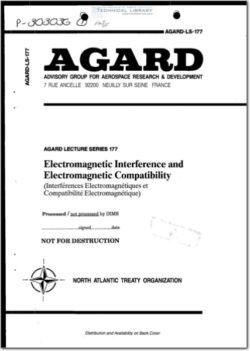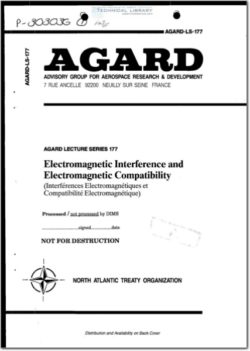AGARD-LS-177

- Version
- 324 Downloads
- 7.02 MB File Size
- 1 File Count
- April 26, 2016 Create Date
- April 26, 2016 Last Updated
Electromagnetic Interference and Electromagnetic Compatibility

Electromagnetic interference (EMI) and electromagnetic
compatibility (EMC) are topics which have been of concern to
the military community for many years. and especially during
the past half century when electrical and electronic equipments
have proliferated. The ability of NATO forces to operate as
planned over the complete range of operational scenarios is
critically dependent on the correct functioning of a wide variety
of electromagnetic (EM) systems, both individually and col-
lectively; therefore, any foreseeable interactions and perform-
ance degradation of such EM systems must be minimised -
preferably by effective design.
Excessive generation of, or susceptibility to. EM noise and
interference, resulting in inadequate EMC. is one potential
source of interaction and performance degradation which may
result in reduced operational effectiveness. For this reason, the
importance of achieving EMC has been stressed within NATO
for at least the last We decades; bodies such as the EMC Sec-
tion within NATO and the NATO EMC Advisory Group have
been responsible for a continuing appraisal and analysis of
actual and predicted EMC problems, leading to recommenda-
tions for action and specific projects. Within AGARD. the
Electromagnetic wave Propagation Panel (EPP) and Avionics
Panel (AVP) have also continued to promote scientific analy-
sis. and discussion of EMI and EMC problems, eg (AGARD,
1974) and (AGARD, 1987).
In general. it can be stated that the military EM environ-
ment is reasonably Well defined in terms. say, of maximum
threat levels; hence. it has also been possible to quantify EMC
requirements with a degree of precision. In the civilian domain,
however, an informed appreciation of the significance of EMI
and EMC has been slower in developing, probably because,
until relatively recently, that environment had a much lower
average density and variety of EM systems than the typical
military situation. Over the past decade, the civilian environ-
ment has become increasingly “rich” in sources of EMI and
hence achieving EMC has now become a significant conCem.
Increased awareness of the likely implications of the installa-
tion of a vast range of EM equipments and systems, unspecified
from an EMC viewpoint, has led to an increasingly comprehen—
sive range of specifications and standards. culminating in the
formulation and ratification of the EMC Directive by the
European Community (BC Council Directive, 1989), by which
virtually all EM equipments and systems manufactured and
sold in the EC will be subject to legal EMC requirements with
effect from 1992.
| File | Action |
|---|---|
| AGARD-LS-177 Electromagnetic Interference and Electromagnetic Compatibility.pdf | Download |

Comment On This Post